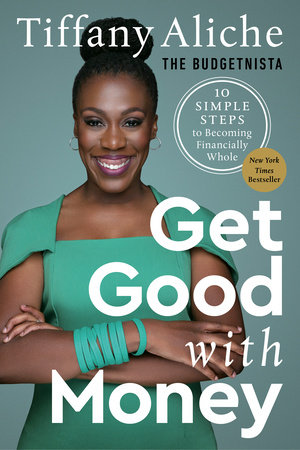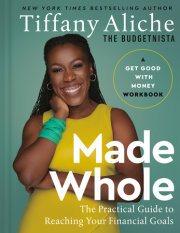Chapter 1Before We Begin: Get to Know Financial WholenessSeven years after starting my business I was making more money a month than I used to make in a year teaching preschool. I had more than enough to live on and was able to dig myself out of my financial hole. I paid off the $35,000 in credit card debt that I’d accumulated from my run-in with Jack the Thief and the overpriced business course (see the introduction if you want to relive all that with me!), and I also paid off my $52,000 student loans. Once I was debt-free I was able to save almost 70% of my income and paid cash for a car (used, but certified and new to me) and a new house. The house was a foreclosure and therefore seriously discounted from what would have been the market price, but it was still a very big ticket item: $180,000. I was even able to pay off the remaining $120,000 on my parents’ mortgage. By most people’s standards, I was rolling in it!
But even though I was doing so well, I was more scared than I ever had been when I was a teacher and making so much less. In fact, despite making so much less then, I’d never been scared about handling my money at all when I was a teacher. So why was I so obsessed with having zero debt and stashing money away just in case? The short answer is that losing everything during the Great Recession had been traumatic, and I was emotionally scarred. I was living in a state of financial fear.
My own financial fears were obviously brought on by actual events—things that happened (and that I could have handled differently)—and so I felt I had a rational reason to fear financial downfall, but really it was an irrational fear of them happening again. Many people, including my former self, understandably live in financial fear based solely on the possibility of financial disaster. If the global pandemic of 2020 has taught us all anything, it’s that the unknown and unpredictable do happen—jobs and income and stability can disappear due to something simply in the air!
But when you are financially whole in the way I’ll teach you to be, you won’t have to live in fear of all that. You’ll have a plan for each area of your finances so that they are constantly working on your behalf, regardless of where you currently are in life. Financial wholeness has nothing to do with the tax bracket you’re in. Anyone, regardless of their income level or employment status—whether you’re making minimum wage or you’re a millionaire—can and should actively work toward becoming financially whole; its principles are relevant and applicable to all. Financial wholeness doesn’t stabilize just one aspect of your financial life, but all aspects of your financial life. This is why it can help you manage and sometimes even thrive during financially traumatic times.
The True Freedom of Financial WholenessLots of financial advisors preach the power of financial freedom, or the idea that it’s possible to have enough money to support your lifestyle without having to work anymore. Sounds good on paper, right? But my own experience shows loud and clear that this kind of freedom won’t make you feel truly free. Despite my postrecession comeback, I was more on track financially as a teacher than I was as a burgeoning business owner earning much more. Why? Because as a teacher, I had a savings strategy, a debt payoff plan in place, a good credit score, adequate insurance for where I was in life, and I knew where my assets would go if I died (my sisters). I had an automated retirement account to which I contributed the maximum allowed each year. I had an emergency savings account and even had multiple streams of income from teaching, babysitting, and tutoring.
When I was financially free, I had a large cash reserve, but I hadn’t achieved many other critical financial pillars I needed to feel secure. I had never adjusted my insurance to cover my new way of life. I didn’t have a clear retirement plan that reflected my newfound standard of living, either. I didn’t have an updated estate plan or a way to grow and sustain wealth versus just save money. And I still didn’t have any place to go for professional financial advice. I was actually losing money because my fear kept me from investing in ways that could grow my wealth beyond my own earnings. Seriously—one financial planner I considered hiring laughed at me for having a ton of money in the bank and hardly any in my retirement account.
I was not at all a millionaire as a teacher. But I was maximizing my income and I had a clear plan in motion for each area of my finances. To repeat: I felt more secure making $39,000/year teaching preschool than I did as a business owner making more than $39,000/month. Just goes to show that a strong foundation can be built with much less than you think. And that wealth is more than just money in the bank!
The Ten Steps of Financial WholenessEven though I haven’t taught in a classroom in many years, I still think in terms of lesson plans and in this book it’s no different. There are ten lessons you need to learn, ten areas of your finances that need to be working in sync for you to get to financial wholeness. When all ten of these facets are in place, you’ll have a strong financial foundation—and that means it would take a lot to knock you down.
Financial wholeness is when all the aspects of your financial life are working together for your greatest good, your biggest benefit, and your richest life.
We’re going to take this a step at a time in the pages to come, but for now here’s the big picture. Here are the ten steps:
1. Budget Building: Learn how to create and semiautomate (automated transfers, bill pay, etc.) a personal budget and open the necessary checking and savings accounts to support your budget.
2. Save Like a Squirrel: Calculate your savings goal number that’s needed to meet at least three months of essential expenses for your household. Then calculate how much you need to save in each category of savings: emergency, goals, and investing. Learn how to prioritize and automate transfers to your savings accounts.
3. Dig Out of Debt: Get a clear picture of who and what you owe by writing down the components of your debt (i.e., amount owed, interest rate, due dates, etc.). Then choose a debt repayment strategy and use your bank’s online bill pay to automate your payoff plan.
4. Score High (Credit): Request your free FICO credit report and score to see where you stand. Make a list of the factors that are impacting your score and come up with a game plan to increase it to a 740 or higher.
5. Learn to Earn (Increase Your Income): List all the ways you’ve contributed value at your job in the last few years to make a good argument for a raise. Uncover your side hustle potential by making a list of the tasks you do at work, your education, and current skill set. Develop an action plan that lists what you’ll do next to increase your income.
6. Invest Like an Insider (Retirement and Wealth): Identify your retirement and wealth goals. Create and implement your investment plans with the help of your Human Resources representative, a certified financial planner, online tools, or by yourself. Commit to consistent contributions toward investing, to learn to leave it alone, and to give it opportunity to grow.
7. Get Good with Insurance: Make sure you have proper insurance coverage. That means understanding and calculating your needs around health, life, disability, property, and casualty (e.g., home and auto).
8. Grow Richish (Increase Your Net Worth): Learn how to calculate your net worth (owning more than you owe) and how to achieve, increase, and maintain a positive net worth. Create a net worth goal and define actions you’re going to take each month to achieve your goal.
9. Pick Your Money Team (Financial Professionals): Find reliable and trustworthy financial professionals (i.e., certified financial planner, insurance broker, estate planning attorney, certified public accountant, etc.) and identify accountability partners.
10. Leave a Legacy (Estate Planning): Create and implement a plan for what will happen to your estate (cash, real estate, jewelry, and other assets) after you pass. This is important no matter the size of your bank account and portfolio (i.e., investments, home, stocks, bonds, etc.).
Now, doesn’t that all sound easy?! Okay, maybe you’re thinking it seems like a lot. But what if I told you these steps have been designed specifically to help you create the financial life you want?
The first five steps cover the fundamentals. Their purpose is to help you create financial stability. Think of these steps as your foundation. The trick is to get to a point that budgeting, saving, debt, credit, and earning become second nature so you can focus most of your energy on the next five steps.
Steps six through ten cover growing and protecting your wealth. They are presented in order to show you how to invest, align your insurance, grow your net worth, seek professional help, and protect your legacy.
Do you realize that you’ve just been handed a road map that will lead you to the kind of financial life that will build and support your bright future? *Insert obligatory shoulder shimmy* It’s all here, complete with detailed directions. I will lead the whole way, and we’ll get you to financial wholeness together. Woot, woot!
Copyright © 2021 by Tiffany Aliche. All rights reserved. No part of this excerpt may be reproduced or reprinted without permission in writing from the publisher.









